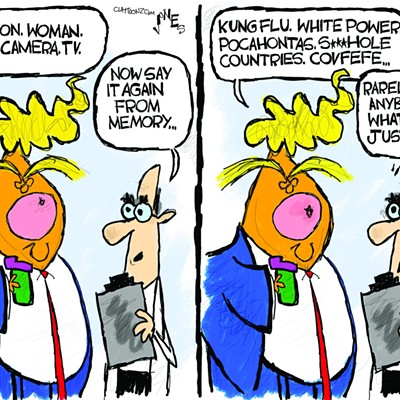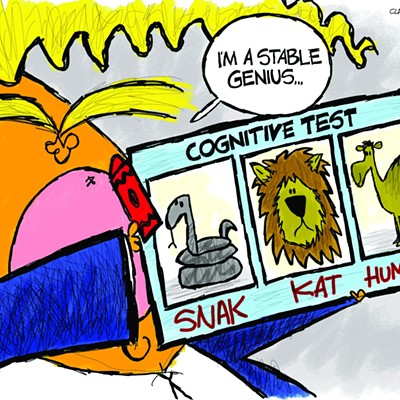You could hardly squeeze more GOP anxieties into one swollen story: Deadbeat local artists defiling the local fire station! An obscene painting of penises funded by local tax dollars! Homeland Security denied the office space needed to fight terrorism!
The only problem with this political wet dream: Not one of the claims is true.
Rumblings about "pornographic" artwork at Tucson's Museum of Contemporary Art began circulating weeks ago in the run-up to the Nov. 3 City Council election, in which a trio of Republicans—Steve Kozachik, Ben Buehler-Garcia and Shaun McClusky—hope to unseat Democratic incumbents Nina Trasoff and Karin Uhlich and win a third open seat against Richard Fimbres. The whisper campaign tried to link the current Democrats on the council with a painting that was exhibited at MOCA way back in 2005, when, by the way, the City Council was dominated by Republicans.
In the artwork in question, artist Jaime Scholnick painted a cascade of cartoon-colored penises tumbling across a blank white paper. She gave her lighthearted piece a humorous title: "Big Dick No. 1." It was included in a temporary group show at MOCA called Quickening, put together by guest curator Julia Latané, a former Tucsonan who had helped found the museum back in 1997 before moving on to Los Angeles.
The "story" exploded publicly last week, when Republican National Committeeman Bruce Ash turned up on KGUN-9 News to accuse the City Council of funding an obscene artwork .
"The Tucson City Council authorized through another committee—a not-for-profit group—the expenditure of a lot of dollars for a piece of art called 'Big Dick No. 1,'" Ash told KGUN reporter Joel Waldman.
Never mind that MOCA didn't spend a penny on the painting. It was a guest piece borrowed for a temporary exhibition. And the exhibition was mounted in the old MOCA building on Toole Avenue, owned by the Arizona Department of Transportation, not the city.
The only money the museum got from the city that year was funneled through the Tucson Pima Arts Council, a city-county agency that gets a good bit of its budget from the state, via the Arizona Commission on the Arts. TPAC's contribution to MOCA was a mere $905. That chunk of change went to general operations—rent, utilities and the like, according to Anne-Marie Russell, the museum's executive director. It did not pay for artwork.
MOCA hasn't gotten any more grants from TPAC since way back in 2006, when the museum was awarded $516. MOCA runs primarily on private grants, including a whopping $100,000 from the Andy Warhol Foundation for the Visual Arts.
After his prime-time appearance on KGUN, Ash now concedes that the show containing "Big Dick No. 1" took place when the City Council was controlled by Republicans Fred Ronstadt, Kathleen Dunbar and Bob Walkup and independent Carol West. (Ronstadt and Dunbar were beaten later that year by Democrats Trasoff and Uhlich.)
Caught with his pants smoldering, Ash is now backing away from his assertion that the current Democratic-controlled City Council had anything to do with "Big Dick No. 1." But he's still trying to tie the Dems to the museum.
After all, he points out, the City Council OK'd a deal to lease the Fire Department's vacated downtown headquarters to the museum for $1 a year. MOCA is set to take possession of the bunker-like building Dec. 1 and open to the public on Feb 6. Ash claims, without evidence, that the federal Department of Homeland Security wanted to lease the building after the Fire Department relocated to spiffy new digs on Cushing Street.
But City Manager Mike Letcher says flatly: "Homeland Security never wanted this building. ... There's just no truth to that rumor."
Ash admits he has no way to substantiate his claims that Homeland Security wanted the fire station building.
"I'm waiting for some information to be presented to me," Ash says. "If I'm able to make it public, I will."
Ash also asserts that the Tucson Police Department wanted the space. Letcher says it's true that the police department, which has headquarters next door to the old fire station, did consider taking over the fire station lot—but that plan proved too costly.
TPD had planned to enlarge its building and demolish the old fire station to make way for a parking lot. But it would have had to pay a cool $1 million just for demolition. And it would have cost the police $52 million to expand their downtown building.
Instead, TPD added a new crime lab at the westside station on Miracle Mile at a cost of $39 million.
Once the city decided against demolition, it put out a call for bids to lease the empty building. MOCA was the only organization that stepped up. Not only would it take the white elephant off the city's hands, it would add a new museum space to a downtown desperately seeking attractions. (The museum has operated out of assorted temporary quarters in recent years.)
MOCA signed a five-year lease at a sweetheart $1 a year, but there are downsides. The city gave itself an exit strategy in the unlikely event it wants the building back. Whenever it wants, the city can terminate the lease by giving the museum one year's notice.
"It's a very low risk on the part of the city," Russell says. "It doesn't give us permanence."
In addition, museum director Russell estimates that the museum will have to spend about $80,000 to transform the firehouse into gallery space, with annual maintenance costs running into the six figures. The city had to pay at least $300,000 a year in maintenance and utility costs to operate the fire station 24 hours a day, according to Letcher.
Ash says he's making comments about the deal strictly as a private citizen, but he was representing an independent political committee, the Tucson Vision Committee, in his appearance on KGUN-9 News last week.
The Tucson Vision Committee has filed only one campaign finance report, although another is due this week. The first filing included only four contributors, including Michael Goodman, a developer who has fought with the City Council over his efforts to build so-called mini-dorms in neighborhoods north of the University of Arizona.
In the KGUN-9 report, Ash showed off a draft of a political ad the committee had put together. The hit piece not only condemned the city council for supporting an art exhibition featuring obscene artwork but for blocking Homeland Security from leasing the downtown fire station. Ash says the committee has decided against running the ad.
ecently ranked 20th among arts-friendly large cities in the U.S., Tucson has largely been spared the political jockeying over so-called obscene art that has hit other cities. But the charge of "obscene art funded with tax dollars" is a familiar narrative that has played out on the national stage at least since 1989.
That year, assorted Republican senators and Christian leaders went on the attack against "Piss Christ," Andres Serrano's infamous photo of a crucifix suspended in urine. The piece had won a prize partly funded by the National Endowment for the Arts.
That same year, the same cohort managed to waylay a planned exhibition of sexually explicit photographs by Robert Mapplethorpe at the Corcoran Gallery Museum of Art that was supposed to get NEA funds.
The last time in memory that Tucsonans got exercised about the issue of "pornographic" art was in 1993. Police staged a raid on a downtown gallery and seized Robyn Stoutenburg's photos of her naked four-year-old son holding a plucked chicken. The Pima County Prosecutor bandied about allegations of "bestiality" that could have landed the artist in jail for 12 years—if she had ever been found guilty by a jury. The uproar died down when people actually got a gander at the photo, a sweet look at a sweet child. The county prosecutor quietly dropped the charges.
MOCA is hardly a museum that displays easy-to-like landscape paintings or cowboy art. It's one of dozens of so-called museums of contemporary art that have sprung up around the country in recent decades, from the acclaimed P.S. 1 in New York City to the Museum of Contemporary Art, Los Angeles, to the Scottsdale Museum of Contemporary Art (SMOCA).
Their mission is to deal with the art of today, and all of the MOCAs strive to stay on the cutting edge. That means challenging the idea of what art is. Tucson's MOCA has exhibited everything from a cake cut and iced to look like the White House to "sculptures" made entirely of yard-sale detritus to searing political paintings by UA prof Alfred Quiroz. And yes, like every museum worth its salt, from the Vatican Museum in Rome to the Metropolitan Museum of Art in New York City to the Tucson Museum of Art, MOCA exhibits works examining the human body and sexuality. Images of penises, breasts and vaginas, among other body parts, are sometimes on display.
Shaun McClusky, one of the Republican City Council candidates, has been critical of MOCA's offerings.
"Some of their displays are not for everyone in society," McClusky says.
The museum's Russell says she has long expected some kind of political attack on MOCA.
"I'm surprised that it took this long," she says. "This is straight out of the playbook."





















